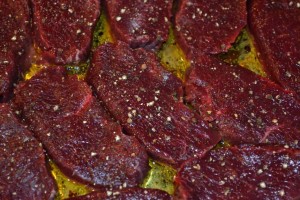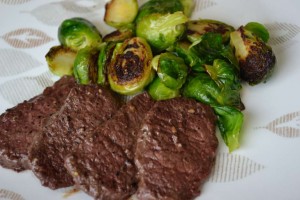One thing you rarely hear people talk about is how they choose to try a new type of meat. I think there is just one way to do it — lightly sauteed with a little salt and pepper. (Unless you get the chance to cook it like we do with Paleo Caribou.) This simple recipe is how you can have a standard that helps you place the meat’s flavor in your repertoire.
We used to use butter for this, but now we use olive oil. Both work well. Slice the meat fairly thin, 1/4 to 1/2 inch, depending on what the animal is and how tough or tender you anticipate the cut of meat will be. Don’t preheat the pan too hot, or the meat sticks too much; you want it to brown, though. Cook the meat lightly so it retains the juices. In a panful, by the time you flip the pieces to cook the second side, some juices should be accumulating in the bottom. As soon as the meat is cooked through, plate it and eat it while still hot. Or just eat it right out of the pan when dealing with small pieces of unusual meats. Afterward, use the fond if possible. Those browned bits and the carmelized meat juices are very tasty. We’ll sometimes cook eggs in the pan afterwards, or, after deglazing it with red wine, the sauce can be poured over rice, potatoes, or pasta. Exquisite.
This method of cooking backstrap has been a favorite of ours for many years, and it’s great with deer, antelope, moose, and caribou. (Backstrap is the muscle at the top of the outside of the rib cage against the spine and is also called chops or loin. After tenderloin, it is the best piece of meat in tenderness and flavor–or maybe the best because it is larger, so it lasts longer.)
P.S. This is how I learned that voles taste like cat food. (Though if I ever wished to try it again, I’d cook it more like cuy–if you should ever want to try it.)


